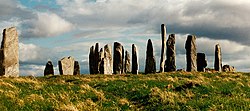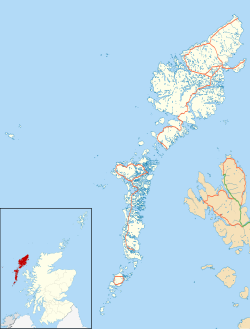Callanish
| |
|---|---|
 A view to Callanish village from the Callanish Stones in summer 2012 | |
Location within the Outer Hebrides | |
| Language | Scottish Gaelic English |
| OS grid reference | NB212333 |
| Civil parish | |
| Council area | |
| Lieutenancy area | |
| Country | Scotland |
| Sovereign state | United Kingdom |
| Post town | ISLE OF LEWIS |
| Postcode district | HS2 |
| Dialling code | 01851 |
| Police | Scotland |
| Fire | Scottish |
| Ambulance | Scottish |
| UK Parliament | |
| Scottish Parliament | |
Calanais (English: Callanish) is a village (township) on the west side of the Isle of Lewis, in the Outer Hebrides (Western Isles), Scotland. Calanais is within the parish of Uig. [1] A linear settlement with a jetty, it is on a headland jutting into Loch Roag, a sea loch 13 miles (21 kilometres) west of Stornoway. Calanais is situated alongside the A858, between Breasclete and Garynahine.[ citation needed ]
The Calanais Stones "Calanais I", a cross-shaped setting of standing stones erected around 3000 BC, are one of the most spectacular megalithic monuments in Scotland. A modern visitor centre provides information about the main circle and other lesser monuments nearby, numbered as Calanais II to X.

